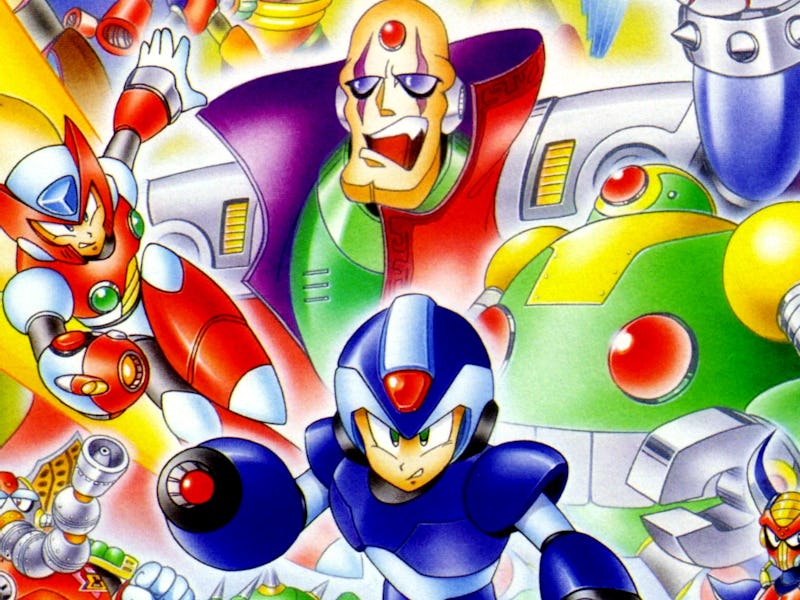Mega Man Would Never Be the Same After this Brilliant ‘90s Sequel
And it’s not too late to play it for yourself.

A little robot person travels across various platforms and themed levels to take on a series of metallic bosses. That could describe pretty much any Mega Man game. But in December of 1993, Capcom decided to push the franchise forward with its boldest sequel yet.
At first glance, Mega Man X doesn’t look too different from the franchise’s prior X-less entries on the Nintendo Entertainment System. And considering how beloved those early games are, Mega Man X could’ve very easily taken a “If it ain't broke, don’t upgrade it” route. But Mega Man X, the first game in the series to debut on the Super Nintendo, made a variety of integral changes that would culminate in one of the most iconic side-scrolling platformers of all time.
The first update came with the leading character, X. Though it’s doubtful that many play the Mega Man franchise for a sense of intricate storytelling, those that take notice of Mega Man X’s narrative involving a group of rogue cyborgs and an evil “reploid” that plans for the annihilation of mankind, can find a change from Mega Man to X. While Mega Man served as a much more straightforward do-gooder, X, an android resuscitated in an uncertain future, deals with actual internal struggles. In a way, it’s kind of a Blade Runner lite, with X questioning his own existence and why he’s fighting against these robots.
Along with the addition of his colder ally Zero (think Shadow the Hedgehog to X’s Sonic,) the cast of Mega Man X is richer than anything previously seen in the series. This includes the villains, which, now in the 16-bit glory of the Super Nintendo, go from being Mega Man-looking warriors to bestial creatures. With boss stage music that became iconic to a generation (It’s hard to imagine fighting Storm Eagle without hearing Makoto Tomozawa’s energetic arrangement preceding the battle), each felt like a character in their own right rather than another gimmicky robot.
To combat those “Maverick” robots, X would assume a staple of Mega Man gameplay. After defeating each boss, X gets the chance to use and switch between their powers. These powers not only change boss battles (especially since you can take on these bosses in whatever order you want) but also let you navigate the levels differently. For example, after beating Chill Penguin’s stage, Flame Mammoth’s stage is devoid of its lava pits, making it much less perilous to navigate.
This makes Mega Man X fascinating to replay since depending on what you have accomplished and the upgrades you attain, you can make new discoveries. For example, if you explore the outskirts of Boomer Kuwanger’s stage and use the Boomerang Cutter under a certain platform, you’ll be able to nab a Heart Tank that is otherwise out of reach.
Box art for Mega Man X.
Those Heart Tanks, which certainly help you survive chaotic levels like Sting Chameleon’s and Spark Mandrill’s, aren’t the only way to power up your protagonist. Accompanied by a message from his creator, Dr. Light, X can find Armor Capsules that install upgrades for his feet so he can quickly dash across stages, his head (unlocking a headbutt ability capable of destroying bits of levels), and his body (basically a suit of armor to reduce damage). These upgrades practically turn Mega Man X into a role-playing game, giving you the option to tailor your hero and his fighting style however you want.
If you encounter a particularly tough boss or level, Mega Man X pushes the player to work through other parts of the game until you can grab a certain item or come up with a new strategy to even the odds. In a way, this meant that Mega Man X could serve as the franchise’s reinvention on a new console. It was a new Mega Man for a new generation, both inside its story and out.
One of the game’s many iconic boss battles.
Mega Man X was widely lauded upon release and since then has served as a benchmark title in the franchise and its wider genre. Capcom and Nintendo have found it fitting for re-release multiple times, from reproducing its cartridge in an anniversary celebration, to including it in emulated form on the Super Nintendo Classic Edition, to releasing a Mega Man X Legacy Collection.
So even 30 years after the game’s original release on December 17, 1993, it’s never been easier to experience Mega Man X and the many ways it enhanced and innovated an already great gaming franchise.